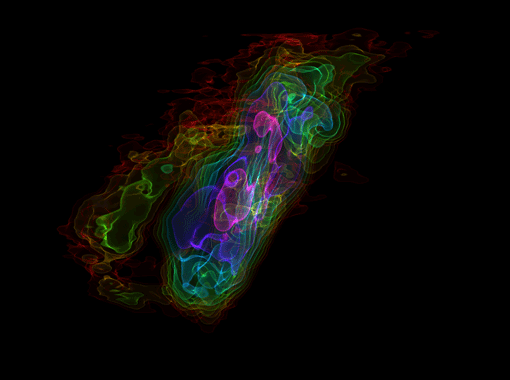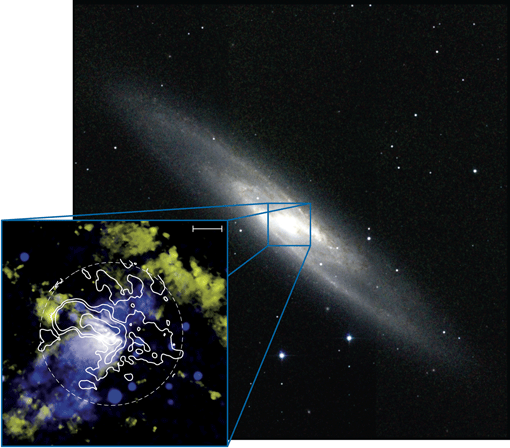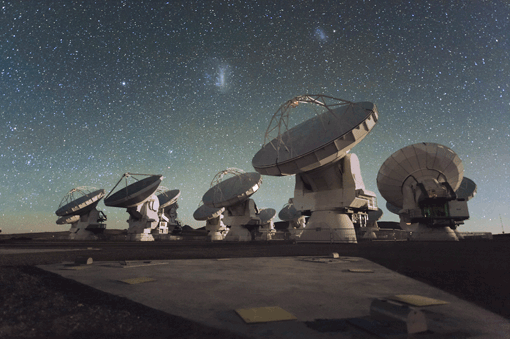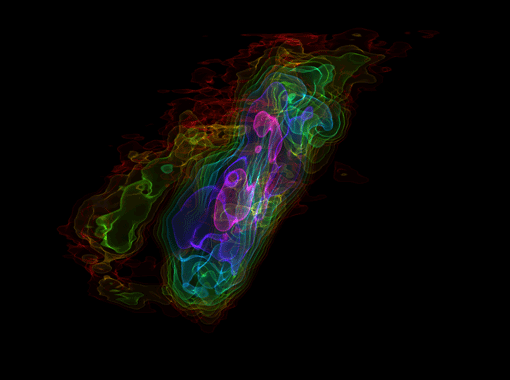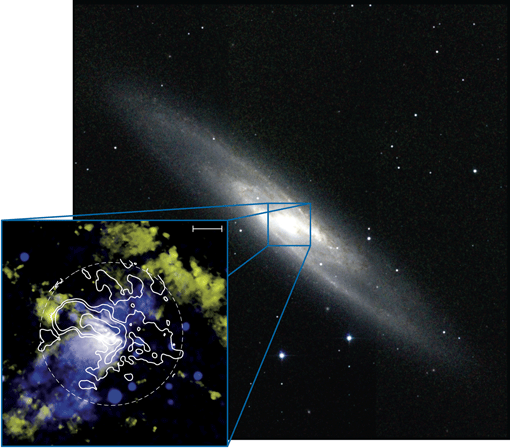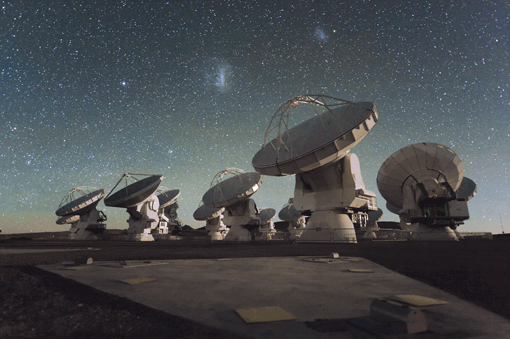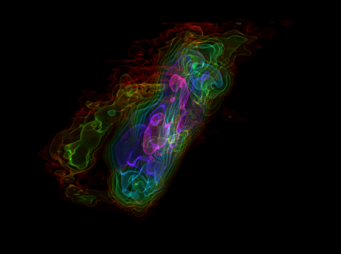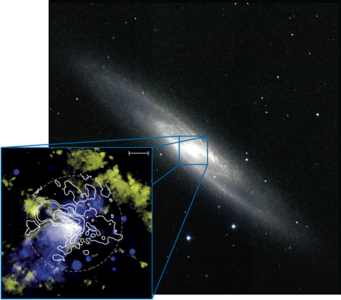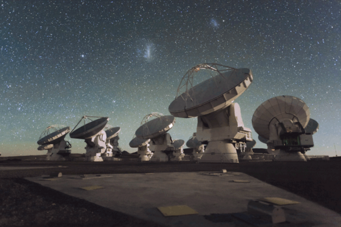Star-formation like there is no tomorrow: NGC 253 and the limits to galactic growth
Astronomers have long assumed that when a galaxy produces too many stars too quickly, it greatly reduces its capacity for producing stars in the future. Now, a group of astronomers that includes Fabian Walter from the Max Planck Institute for Astronomy were able to obtain the first detailed images of this type of self-limiting galactic behavior: an outflow of molecular gas, the raw material needed for star formation, that is coming from star-forming regions in the Sculptor Galaxy (NGC 253). The study, which uses the newly commissioned telescope array ALMA in Chile, is published in the journal Nature on July 25, 2013.
| Background information | Questions & Answers | Image download |
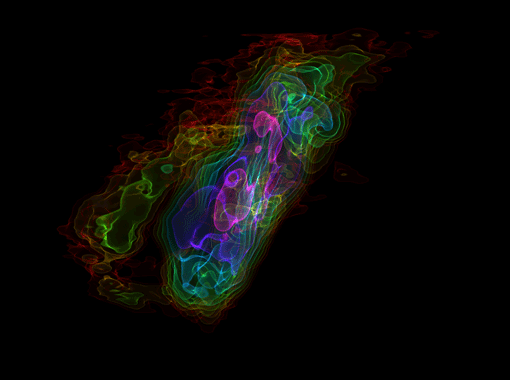
Galaxies – systems that contain up to hundreds of billions of stars, like our own Milky Way galaxy – are the basic building blocks of the cosmos. One ambitious goal of contemporary astronomy is to understand the way that galaxies evolve from the first proto-galaxies shortly after the big bang to the present. A key question concerns star formation: what determines the number of new stars that will form in a galaxy?
A key ingredient of current models of galaxy evolution are mechanisms by which ongoing star formation can actually inhibit future star formation: When new stars are formed, a certain fraction of them are very massive. Massive stars shine brightly, and their intense radiation drives "stellar winds", outflows of gas and plasma that can be sufficiently strong to push gas out of the galaxy altogether. Also, massive stars end their comparatively brief lives in spectacular explosions (supernovae), flinging their outer shells – and any additional material that might be in their way – out into space. Consequently intensive star formation, known as a "starburst", and the resulting formation of many massive stars, can hamper the growth of future generations of stars. After all, molecular gas that has been flung out of a galaxy cannot serve as raw material from which to fashion that galaxy's new stars. There is a limit to galactic growth.
So far, so good – but what was missing was direct observational evidence for starbursts producing outflows of molecular gas. Until now, that is, when a team of astronomers led by Alberto Bolatto from the University of Maryland at College Park observed the starburst galaxy NGC 253.
NGC 253, also known as the "Sculptor Galaxy", is a spiral galaxy located in the constellation Sculptor in the Southern sky. With a distance of 11 million light-years it is one of our closer intergalactic neighbors and the closest starburst galaxy visible from the southern hemisphere. Using the compound telescope ALMA the astronomers targeted the central regions of NGC 253, where the most intense production of new stars takes place, and found a telltale outflow of molecular gas at right angles to the galactic disk.
Bolatto, who is the lead author of the study now appearing in the journal Nature, concludes:"The amount of gas we measure gives us very good evidence that some growing galaxies spew out more gas than they take in." Indeed, the astronomers estimate that each year the galaxy ejects gas with a total mass of nine times that of our Sun. This ejected mass is about three times larger than the total mass of all stars produced by NGC 253 each year (which, in turn, is several times larger than the mass of all stars produced in our home galaxy, the Milky Way, each year).
Fabian Walter from the Max Planck Institute for Astronomy, a co-author of the study, adds:"For me, this is a prime example of how new instruments shape the future of astronomy. We have been studying the starburst region of NGC 253 and other nearby starburst galaxies for almost ten years. But before ALMA, we had no chance to see such details." The study used an early configuration of ALMA with only 16 antennas. "It's exciting to think what the complete ALMA with 66 antennas will show for this kind of outflow!" adds Walter.
Background information
The work described here will be published as Bolatto et al., "Suppression of star formation in the galaxy NGC 253 by a starburst-driven molecular wind" in the July 25, 2013 edition ofNature.
The team members are Alberto D. Bolatto, Steven R. Warren (both University of Maryland, College Park [UMD]), Adam K. Leroy (National Radio Astronomy Observatory [NRAO]), Fabian Walter (Max Planck Institute for Astronomy [MPIA]), Sylvain Veilleux (UMD), Eve C. Ostriker (Princeton University), Jürgen Ott (NRAO), Martin Zwaan (European Southern Observatory), David B. Fisher (UMD), Axel Weiss (Max Planck Institute for Radio Astronomy), Erik Rosolowsky (University of British Columbia) and Jacqueline Hodge (MPIA).
Bolatto is currently visiting the Max Planck Institute for Astronomy for a 6 month sabbatical.
The Atacama Large Millimeter/submillimeter Array (ALMA), an international astronomy facility, is a partnership of Europe, North America and East Asia in cooperation with the Republic of Chile. ALMA is funded in Europe by the European Southern Observatory (ESO), in North America by the U.S. National Science Foundation (NSF) in cooperation with the National Research Council of Canada (NRC) and the National Science Council of Taiwan (NSC) and in East Asia by the National Institutes of Natural Sciences (NINS) of Japan in cooperation with the Academia Sinica (AS) in Taiwan. ALMA construction and operations are led on behalf of Europe by ESO, on behalf of North America by the National Radio Astronomy Observatory (NRAO), which is managed by Associated Universities, Inc. (AUI) and on behalf of East Asia by the National Astronomical Observatory of Japan (NAOJ). The Joint ALMA Observatory (JAO) provides the unified leadership and management of the construction, commissioning and operation of ALMA.
Questions and Answers
What is new about these observations?
Outflows of this nature had been postulated for a long time. Earlier studies of NGC 253 using X-ray observations had already shown very thin and hot gas streaming out of those regions. But this is the first direct evidence that large amounts of molecular gas, the raw material for star formation, are caught up in the exodus – and thus the first direct evidence that these outflows indeed limit the galaxy's capacity for future star formation.
Which telescopes were used in this study, and what was observed?
The observations take advantage of the international compound telescope ALMA (Atacama Large Millimeter/Submillimeter Array) that is currently under construction in Chile, which allows astronomers to map radiation with wavelengths in the millimeter/submillimeter range with unprecedented detail. The astronomers mapped radiation from carbon monoxide molecules, which are closely associated with the molecular hydrogen that is essential to form new stars. Additional data was taken with the 22-metre Mopra Radio Telescope, located near Coonabarabran, New South Wales, which is part of the Australia Telescope National Facility operated by the Australian research organization CSIRO. For comparison, image date obtained with the NASA/ESA Hubble Space Telescope, NASA's Chandra X-Ray Satellite, and at Cerro Tololo Inter-American Observatory was utilized.
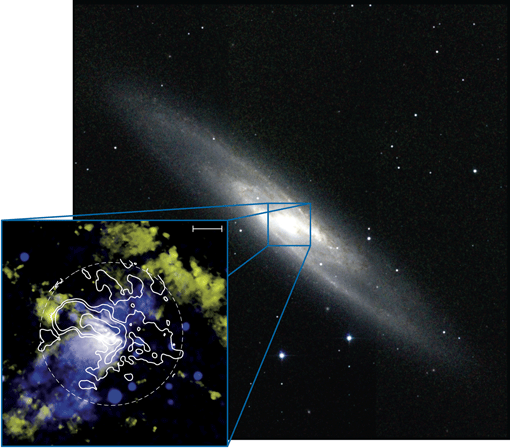
Abbildung 2: Bild der Spiralgalaxie NGC 253. Das kleinere Falschfarbenbild zeigt die Zentralregion der Galaxie und fasst eine Vielzahl von Informationen zusammen, die aus astronomischen Beobachtungen der Galaxie NGC 253 gewonnen wurden. In blau ist Röntgenstrahlung zu sehen, die von sehr heißem Plasma abgestrahlt wird. Dieses Plasma wird aus den Gebieten mit hoher Sternbildungs-Aktivität (Starburst) in der Zentralregion von NGC 253 ausgestoßen. Für Wasserstoffatome charakteristisches Licht (genauer: das Licht, das bei der Rekombination von Wasserstoffionen frei wird) ist gelb dargestellt.
Es zeigt sowohl die Plasmaströmung als auch diejenigen Gebiete im Zentrum und den Spiralarmen, in denen derzeit gerade neue Sterne entstehen. Die weißen Konturlinien stellen die Strahlung des molekularen Gases dar, die ALMA beobachtet hat. Dieses Gas ist zum einen im Zentrum konzentriert – als Rohmaterial für den Starburst. Den entscheidenden Hinweis gibt das Vorhandensein von molekularem Gas an den Rändern der Gasströmung (dessen Röntgenstrahlung blau dargestellt ist). Offenbar lässt die Starburst-Aktivität große Mengen von molekularem Gas ausströmen. Dieses Gas steht für die Entstehung neuer Sterne dann erst einmal nicht mehr zur Verfügung.
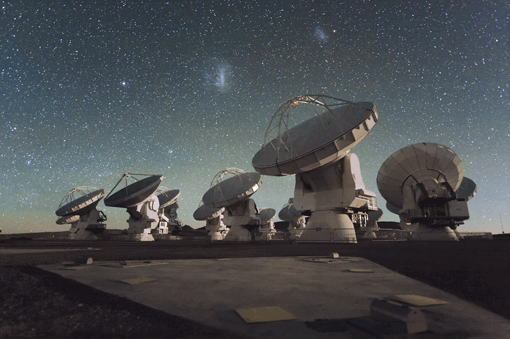
Download area
